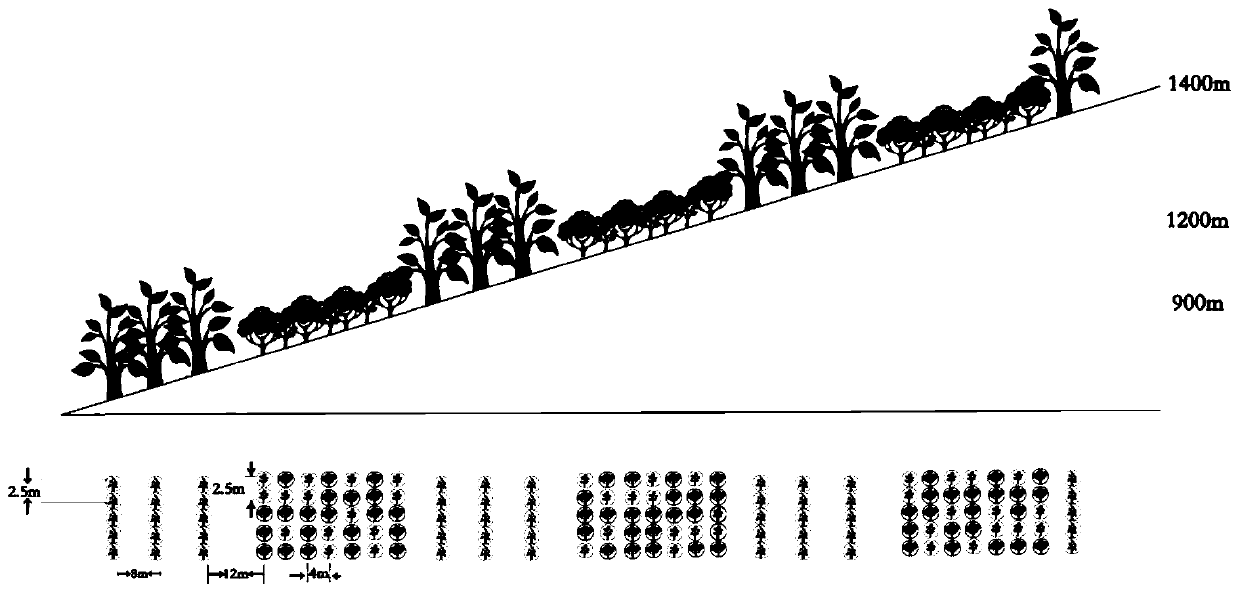A kind of afforestation method for reforming and restoring tropical rainforest by rubber forest
A tropical rainforest and rubber technology, applied in the field of forest cultivation, can solve problems such as tropical rainforest restoration, single forest structure, soil erosion, etc., to increase species and genetic diversity, enrich space and age structure, and ecological impact of logging small effect
- Summary
- Abstract
- Description
- Claims
- Application Information
AI Technical Summary
Problems solved by technology
Method used
Image
Examples
Embodiment 1
[0037] The afforestation method of rubber forest of the present invention restores and transforms tropical rainforest, and concrete steps are as follows:
[0038] 1. The first rubber forest felling and reforestation:
[0039] 1.1 The first felling of the rubber forest
[0040] Such as figure 1 As shown, for the rubber forests that need to be transformed in the project area, strip harvesting is carried out along the horizontal planting platform. Every 3 rows of rubber trees are kept, and 4 rows of rubber trees are harvested. The felling direction is upwards along the slope, and the height of the felling piles is strictly controlled within 5cm. Logging is carried out during the dry season to minimize disturbance to the soil and understory vegetation.
[0041] 1.2 The first rainforest restoration
[0042] Such as figure 1 As shown, in the year when the rubber forest was harvested, a natural recovery zone of about 12m wide was reserved in the lower part of the felling zone, a...
Embodiment 2
[0052] A 30-year-old rubber forest with an area of 500 mu in Jinghong City, Yunnan Province, the rubber forest land is 800-900m above sea level, the plant spacing is 2.5m, and the row spacing is 8m. In 2010, the technology of the present invention was used to restore the rainforest. According to the altitude range of the forest land, the target rainforest community designed for restoration is Parashorea chinensis--Pometia tomentosa forest.
[0053] In 2010, during the first felling of the rubber forest reconstruction, strip felling was carried out along the horizontal planting platform, and for every 4 rows of rubber trees felled, 3 rows of rubber trees were kept. The lower part of the logging zone is reserved for a natural recovery zone about 12 meters wide (1.5 times the rubber row spacing), and no forestation is made on it. In other parts of the logging zone, in June of that year, the dominant tree species (Wangtian tree and Longan tomentosa) and associated tree species (...
Embodiment 3
[0060] A piece of rubber forest at an altitude of 900-1000 meters in Xishuangbanna needs to be restored to a tropical rainforest. According to the altitude distribution of local zonal vegetation, the restoration will be carried out with the goal of tropical mountain rainforest. The target community is Parakmeria yunnanensis--Dacrycarpus imbricatus forest, and the afforestation tree species include dominant species: Pseudomonas yunnanensis and Pine pine; associated tree species are: Manglietia insignis, Engelhardtia spicata, Castanopsis argyrophylla and Schima wallichii; interlayer plants are: Smilax china, Smilax china, Melicopepteleifolia, Lasianthus hookeri, and Calamus henryanus. According to the method of the embodiment of the present invention 2, the rubber forest is felled twice and afforested twice, and finally a heterogeneous forest with multiple tree species and multi-source multi-layer structure is formed. Potential for natural restoration.
[0061] Table 2 Comparis...
PUM
 Login to View More
Login to View More Abstract
Description
Claims
Application Information
 Login to View More
Login to View More - R&D
- Intellectual Property
- Life Sciences
- Materials
- Tech Scout
- Unparalleled Data Quality
- Higher Quality Content
- 60% Fewer Hallucinations
Browse by: Latest US Patents, China's latest patents, Technical Efficacy Thesaurus, Application Domain, Technology Topic, Popular Technical Reports.
© 2025 PatSnap. All rights reserved.Legal|Privacy policy|Modern Slavery Act Transparency Statement|Sitemap|About US| Contact US: help@patsnap.com



